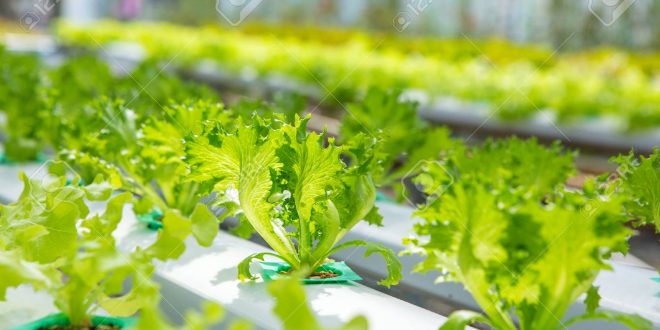Plant breeding is defined as identifying and selecting desirable traits in plants and combining this into one individual plant. Since 1900, Mendel’s laws of genetics provided the scientific basis for plant breeding. Selection is the most ancient and basic procedure in plant breeding. Selection procedures used in plant breeding have gradually developed over a vary long time span, in fact since settled agriculture was first undertaken. It generally involves three distinct steps. First, a large number of selections are made from the genetically variable original population. Second, progeny rows are grown from the individual plant selections for observational purposes. After obvious elimination, the selections are grown over several years to permit observations under different environmental conditions for making further eliminations. And the whole these processes are categorized into three ways of selection. They are:
- Mass Selection
- Pure-line Selection
- Clonal Selection
Finally, the selected and inbred lines are compared to existing commercial varieties in their yielding performance and other aspects of agronomic importance. Here three modes of artificial selection process are described in broad.
In this article, types and procedures of selection process (Mass, Pure-line & Clonal Selection) will be discussed briefly.
Best safe and secure cloud storage with password protection
Get Envato Elements, Prime Video, Hotstar and Netflix For Free
Best Money Earning Website 100$ Day
#1 Top ranking article submission website
Mass Selection
It is suggested by Gardner in 1961. It can be defined as selection of a number of phenotypically superior plants or seeds from the field population, harvesting and bulking their produce together for sowing the next year’s crop and repeating this process till desired characters are achieved. It is followed both in self-defective and cross-pollinated crops.It is the simplest and oldest method of crop improvement.
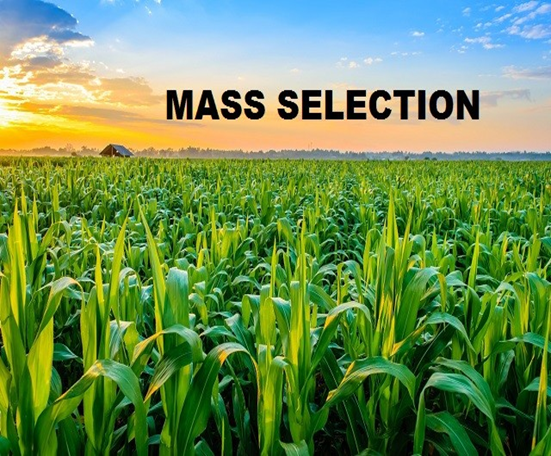
Features of Mass Selection
The main features of varieties developed by mass selection in self and cross pollinated species are given below:
1. Application
Mass selection is applicable to both self and cross pollinated species. However, it is more commonly used in the improvement of cross pollinated crops than in self pollinated species. This method is rarely used in vegetatively propagated crops.
2. Genetic Constitution
In self pollinated crops, a mass selected variety is homozygous but heterogeneous, because it is a mixture of several pure-lines. In cross pollinated crops, such varieties are mixture of homo and heterozygotes and are heterogeneous, because they consist of several homo and heterozygous genotypes.
3. Adaptation
Mass selected varieties have wide adaptation and are more stable against environmental changes due to heterogeneity which provides better buffering capacity. In other words, mass selected varieties have broader genetic base than pure lines. They exhibit more or less stable performance. However, adaptability is more in cross pollinated crops than in self pollinated species.
4. Variation
They are composed of several pure lines in self pollinated crops and of several homo and heterozygous genotypes in cross pollinated crops. Hence there is heritable variation in the mass selected varieties, besides environmental variation. The heritable variation provides them good buffering capacity.
5. Selection
Selection is effective in case of mass selected varieties of self pollinated crops due to presence of heritable varieties. However, further selection in the mass selected varieties of cross pollinated crops may lead to inbreeding depression.
6. Quality
A variety developed by mass selection is less uniform in the quality of seed than pure-lines due to presence of heritable variation.
7. Resistance
Mass selected varieties are less prone to the attack of new diseases due to genetic diversity. In other words, they are more resistant or tolerant to new diseases.
8. Roguing
Periodic removal of off type plants is essential to maintain the yield of mass selected varieties.
Types of Mass Selection
Two types of mass selection. They are:
- Positive screening: Which involves identifying and preserving the most desirable plants from mixed population and their seeds are mixed population and their seeds are mixed together to grow further generation.
- Negative screening: A screening technique designed to identify and eliminate the least desirable plants from the field and rest are allowed to grow further generation.
Procedure
- Step-1: Individual plants (200-2000) are selected on the basis of phenotypic performance for characters like height, maturity, disease resistance, productivity etc (first year). The selected seeds are harvested and mixed together to grow next generation.
- Step-2: Grow individual plant progeny (Second year). The crop is grown from the bulk seed of selected plants in a separate field using standard variety as a check for comparison of performance. In other words, material is evaluated in preliminary yield variety.
- Step-3: The performance of bulk is evaluated for yield and adaption in many yield trials for (3 to 4 years) using standard check for comparison. Multi-location yield trial (4 to 6 years)
- Step-4: The variety is released and named in seventh year and seed is multiplied. In the eight year, seed is ready for distribution.
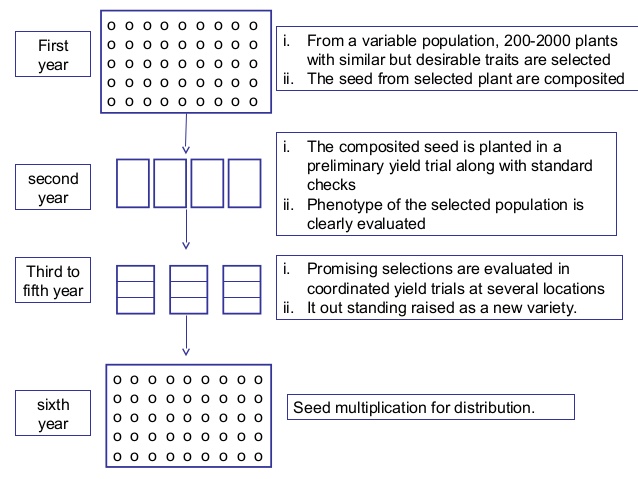
Merits of Mass Selection
- Since a large number of plants are selected, the adaptation of original variety is not changed. It is generally excepted that a mixture of closely related pure-lines is more stable in performance over different environments than a single pure-line. Thus varieties developed through mass selection are likely to be wide adapted than any other selection.
- It is also used for the purification of improved varieties.
- Mass selection varieties are more stable in their performance than pure-lines. In other words, they have more buffering capacity than pure-lines due to heterogeneity.
- Mass selected varieties have good provide good protection against diseases.
- This method is applicable to both self and cross pollinated species.
- Easy and simple method of crop improvement. Often extensive and prolonged yield trials are not necessary thus reducing the time and cost needed for developing a new variety.
- Mass selection retains considerable genetic variety. Therefore, another mass selection after few years would be effective in improving the variety further.
Demerits of Mass Selection
- The selection is based on the phenotypic performance. The superior phenotype is not always an indication of superior genotype. The real breeding value of single plants can be judged from the performance of their progeny. Progeny test is not carried out in mass selection.
- In the absence of progeny test, it is not possible to determine if the selected plants are homozygous. Even in self pollinated species, Some degree of cross pollinated does occur. Thus there is some chance that some of plants may be heterozygous. It is also not known that the phenotypic superiority of the selected plants is due to the environment and genotype.
- The varieties developed through mass selection show variation is not as uniform as pure-line selection. Therefore, such varieties are generally less liked than pure-line varieties.
- Mass selection is not commonly used in the improvement of self-pollinated crops.
- Varieties developed by mass selection are more difficult to identify than pure-lines in seed certification programmes.
- In cross pollinated species, there is no control on the pollination. The selected plants are pollinated by both superior and inferior pollen parents. The results in rapid deterioration of variety developed by mass selection.
Pure-line Selection
The term pure line and pure line selection method for crop improvement was suggested by Johannsen (1903). He conducted Pure line selection method in “princess variety of beans (Phaseolus vulgarizes).” A pure-line is the progeny of a single, homozygous self-pollinated plant. As a result, all the individuals within a pure-line has identical genotype, and any variation within a pure-line is solely due to the environment. In pure-line selection, a large number of plants are selected from a self-pollinated crop and are harvested individually; individual plant progenies from them are evaluated, and the best progeny is released as a pure-line variety. Therefore, pure-line selection is also known as individual plant selection.
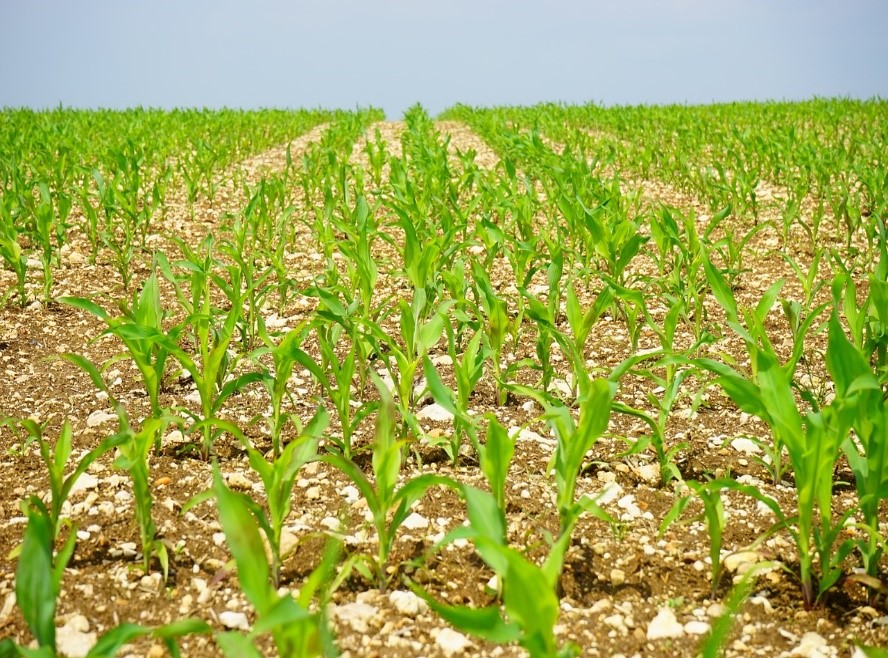
Features of Pure-line Selection
1. Homogeneous
All the genotypes of a pure-line are homogeneous i.e. genetically identical and phenotypically similar. Thus pure-lines are homozygous and homogeneous.
2. Non-Heritable Variation
The variation within a pure-line is entirely due to environmental factors. Thus the variation is non-heritable in the pure-lines.
3. Highly Uniform
A variety developed by pure-line selection is highly uniform in quality due to absence of genetic variation.
4. Selection is Ineffective
Selection is ineffective in a pure-line due to lack of heritable variation. Selection is effective when heritable variation is present.
5. Narrow Adaptation
Generally, pure-line varieties have narrow adaptation and poor adaptability than heterogeneous populations. The poor adaptability is due to narrow genetic base.
6. More Prone to New Diseases
Pure-line varieties are more prone to the attack of new diseases due to genetic uniformity and narrow genetic base.
7. Isolation of Pure-Lines
Pure-lines can be isolated from heterogeneous population as well as segregating populations through individual plant selection and progeny testing.
8. Sources of Variation
In a pure-line variety, natural out crossing, mutations and mechanical mixtures are the important sources of genetic variation. The spontaneous mutations cannot be controlled. Other two factors can be controlled.
Procedure
The procedure of pure-line selection are given below
- Step-1 (Select desirable plants): Seed from each selection is harvested individually (1 yr.)
- Step-2 (Single plant progeny rows grown out): Selected progenies are harvested individually (2 yr)
- Step-3 (yield trials): In subsequent years, run replicated yield trials with selection of highest yielding plants (3 yr). Multi-location yield trial (4-6) year.
- Step-4 (Seed multiplication): After seventh year, highest yielding plant is put forwarded as a new cultivar. Progeny superior to check variety is released as a new variety. Seed multiplication begins for distribution.
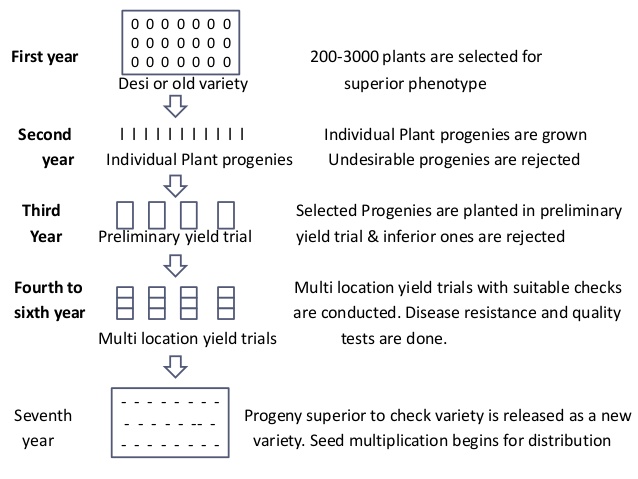
Merits of Pure-line Selection
1. This is a good method of isolating the best genotype for yield, disease resistance, insect resistance, earliness, quality etc. from a heterogeneous, or mixed population of an old variety.
2. The variety developed by this method is uniform and more attractive than mass selected variety. They are therefore preferred by farmers and consumers to a less uniform variety developed through Mass Selection.
3. Due to extreme uniformity variety is easily identified in seed certification programmes.
4. This is an easy and cheap method of crop Improvement.
5. Superior varieties have been isolated by pure-line selection from the heterogeneous populations in several self-pollinated crops like wheat, barley, paddy, peanut, chickpea, black-gram, green-gram, linseed, cotton and tobacco. Pure-lines are used either as varieties or as parents in hybridization for development of superior varieties or hybrids in self-pollinated species.
Demerits of Pure-line Selection
1. The varieties developed through Pure-line selection generally do not have the wide adaptation and stability in the production possessed by the local varieties from which they are developed.
2. Pure-line selection requires more time, space and expensive yield trials than Mass selection.
3. The improvement is dependent on the genetic variation present in the original population.
4. Isolate only superior genotypes from mixed population.
5. In pure-line selection, new variety can not be developed by breeders.
6. The selection method is applicable only in Self -pollinated crops.
7. Poor adaptability due to narrow genetic base.
8. More prone to the attack of new disease due to genetic uniformity.
Clonal Selection
Progeny of a single plant obtained by asexual reproduction is known as clone. A procedure of selecting superior clones from the mixed population of asexually or by vegetative means are known as asexually propagated or vegetatively propagated or clonal crops. Clonal selection is one of the methods for improving the vegetative propagated crops such as sugarcane, banana, potato, citrus, sweet potato, mango, apple, orange, grapes, litchis etc.
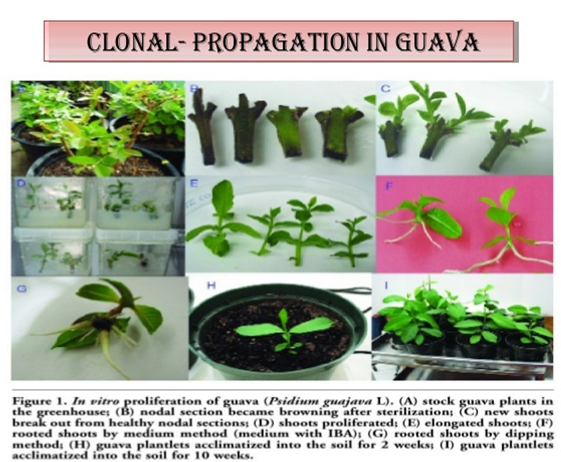
Features of Clonal Selection
1. Clones are stable- They retain their original traits just like pure line variety
2. Theoretically clones are immortal i.e. A clone can be maintained indefinitely by asexual reproduction. However, these are very much susceptible to diseases or insect pests depending upon the species and cultivars.
3. Homogeneous-Individual plant of a clone is a mitotic derivative of the same plant and therefore homogeneity in phenotype is the major feature of clones. A group of individual plants derived from the same tissue of the original mother plant carries the same genotype.
Phenotypic variation if any in clones is due to environmental impact.
4. Continuous inbreeding of clones which are heterozygous might lead to severe loss in vigour.
5. The phenotype of a clone is due to effect of gene (G), environment (E) and GxE interaction over the population mean (h). Therefore P=h+G+E+GE
6.Clones are maintained by asexual reproduction, but pure lines and inbreds are maintained by self-pollination or close inbreeding.
Procedure
- Step-1: In the first year, superior plants selected from mixed population of vegetatively propagated crops; on the basis of yield, maturity and disease resistance etc.
- Step-2: In the second year, the progeny of each selected plant is asexually propagated and grown separately for seed increase and evaluation. Clones superior to check variety are selected and evaluated in replicated preliminary yield trials in the third year.
- Step-3: clones are evaluated in multi-location trial for 3-4 years using standard variety as a check. Clones which is superior to check variety in yield, disease resistance and quality are selected for release.
- Step-4: The best clones are released as improved variety once enough seeds are multiplied for distribution.
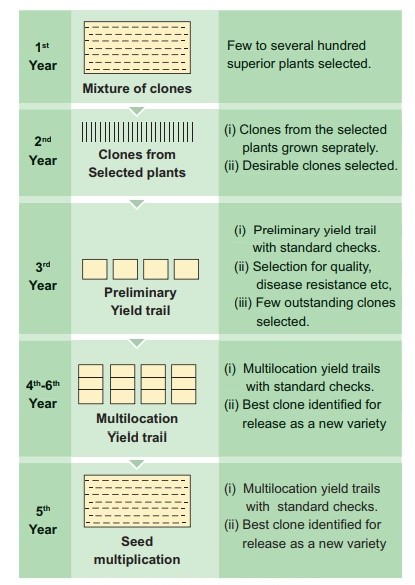
Merits of Clonal Selection
i) Clonal selection is an easy and less time consuming method.
ii) Easy maintenance because there is no problem of out crossing and loss of seed viability. Variation occurs due to somatic mutation only which can be managed by removal of undesired plants.
iii) Heterotic clones on selection may be used as permanent hybrids. Heterosis can be exploited for longer time without production of hybrid seed every year (for vegetatively propagated vegetable crops).
iv) Clonal selection is the only method of breeding in vegetatively propagated fruit plants.
Demerits of Clonal Selection
- There is limited chance of getting new and useful type of variability
- The multiplication rate is low.
- It is only useful for vegetatively propagated plants.
Reference
- https://link.springer.com
- https://www.bats.ch/bats/publikationen
- https://www.botanylibrary.com
- https://www.yourarticlelibrary.com
Revised by
- Saifun Nahar Smriti on 4th October, 2020.
 Plantlet The Blogging Platform of Department of Botany, University of Dhaka
Plantlet The Blogging Platform of Department of Botany, University of Dhaka
